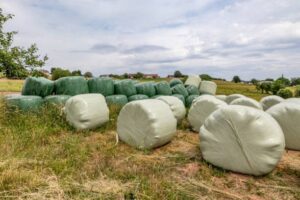Silage wrap is used to preserve hay or straw bales’ quality and nutritional value, so they can be turned into feed for livestock without using expensive chemicals. This process helps minimise chemical usage.
Wrapping forage crops with plastic helps prevent weed growth and encourage more efficient fermentation, as well as keeping moisture from seeping into the ground.
It Prevents Moisture
Silage wrap Australia is designed to keep moisture out of hay or straw bales it covers, helping prevent silage from molding or rotting and reduce nutrients lost through mold or rot. Furthermore, this helps avoid the need for herbicides or manual weeding.
 Protecting hay or straw crops from insects and rodents that would otherwise consume it helps preserve its nutrient content, prolonging animal feedings without having to dispose of it as trash – thus giving farmers an opportunity to capitalise from these crops without tossing them out as waste.
Protecting hay or straw crops from insects and rodents that would otherwise consume it helps preserve its nutrient content, prolonging animal feedings without having to dispose of it as trash – thus giving farmers an opportunity to capitalise from these crops without tossing them out as waste.
Silage wrap is made from tough and flexible materials designed to withstand adverse weather conditions and rugged terrain, making it easy for users to use and store. Stretchable and accommodating the shape of a bale’s shape make silage wrap an effective alternative to other products like hay sleeves that do not offer as many benefits.
Silage wraps can vary significantly across the market, each offering different characteristics that suit different applications. Some offer greater UV protection or tact (stickiness). It is essential that you find one that best meets your needs by either looking closely at its packaging or speaking to a specialist.
It Prevents Oxygen
Silage quality depends upon limiting the amount of oxygen entering bales, since excess airflow allows aerobic bacteria and fungus to flourish, spoiling its forage quality.
Silage wrap provides an efficient means of protecting ensiled forage from oxygen penetration from air and water sources, thus maintaining its nutritional content and supporting livestock welfare by offering them a healthy diet.
Bales wrapped with Silage wrap Australia can benefit from having a tight seal that keeps out moisture, which could encourage harmful microbes that reduce quality and nutritional value of forage.
High-quality silage wrap should provide a tight seal around round and square bales of all sizes, making transport and storage less of an inconvenience for farmers. A thick enough layer should withstand any tears, punctures or damage that might occur during storage and transport – this thickness also needs to be easily adjustable with any baler; its material should also be made up of 100 percent virgin materials to maximise durability while making for quick use and convenience for farmers.
Best practices for ensiling include chopping forage to an appropriate particle length, harvesting at an ideal moisture level for both crop and storage structure, packing tightly by spreading and compacting, sealing storage immediately after, and sealing immediately afterwards to minimise oxygen exposure during fermentation and reduce spoilage risks. Silage exposed for too long may develop unfavourable fermentation acids as well as pH drops leading to spoilage issues that will compromise its shelf life and spoilage potential.
It Prevents Weed Growth
Silage wrap can help farmers maintain high-quality forage while simultaneously controlling weeds in their fields. By depriving the weeds of sunlight and creating a warm, damp environment that prevents their germination, silage wrap is an efficient means of controlling them – both fallow fields to create a seedbed free from weeds as well as fresh ground prior to planting for quick and convenient weed control solutions.
Silage wrap Australia should be wrapped near their storage areas to minimise additional handling, thus minimising risk of damage and contamination. Once wrapped, forages should not be moved for 24 hours post-wrapping to prevent burst fermentation gases.
Preparing the surface of a bale or pile prior to wrapping can dramatically enhance its durability and longevity and prolong the film’s durability and lifespan. Sharp objects, excess moisture, debris, and any sharp objects should be cleared from its surface before adding preservative products like propionic acid which have quick water solubility for quick absorption into forage to stop yeast and mold growth.
It Prevents Bird Damage
Silage wrap helps preserve the nutritional content in forage crops such as grass, maize, hay and vegetables by encouraging anaerobic fermentation and increasing shelf-life; making forage easier to store, transport and sell; while its elastic property prevents moisture penetration into the ground and thus fungus growth. Silage film offers an eco-friendly, cost-effective and flexible solution for maintaining crop nutrients and increasing feed value.
There are various types of silage wrap on the market, each offering distinct advantages and disadvantages. When selecting one for use in your operation, be sure it meets its specific requirements as well as considerations such as its thickness, durability and overall quality.
Selecting the ideal Silage wrap Australia is key to providing your livestock with high-quality feed. Make sure it can withstand weathering and is airtight to preserve nutrients in your crops.
Silage wrap comes in several forms, from tube wrapping and single bale wrap, which each offer unique advantages for producers who wish to streamline the production and storage processes for hay and silage production. Tube wrapping may provide greater efficiency and preservation; however, larger equipment may be necessary, and it could prove more expensive than single bale wrap.
